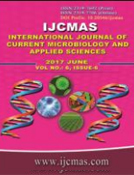


 National Academy of Agricultural Sciences (NAAS)
National Academy of Agricultural Sciences (NAAS)

|
PRINT ISSN : 2319-7692
Online ISSN : 2319-7706 Issues : 12 per year Publisher : Excellent Publishers Email : editorijcmas@gmail.com / submit@ijcmas.com Editor-in-chief: Dr.M.Prakash Index Copernicus ICV 2018: 95.39 NAAS RATING 2020: 5.38 |
Molecular characterization is helpful in understanding the phylogenetic relationship among various germplasm to reveal the genetic diversity among the plant genotypes. Morphological and biochemical markers used for discriminating cultivars / varieties are not adequate as they are subject to environmental influences, whereas the molecular markers especially DNA based, have proven better. The latter may or may not correlate with phenotypic expression of a genomic trait. Varietal profiling methods that directly utilize DNA have been found to potentially address all the limitations associated with morphological and biochemical data. They offer numerous advantages over conventional, phenotype-based characters as they are stable and detectable in all situations regardless of growth, differentiation, development or defense status of the cell. Additionally, they are not confounded by environmental, pleotropic and epistatic effects. The DNA markers become the marker of choice for the study of crop genetic diversity, especially those based on DNA sequence variations which are increasingly being utilized in crops for construction of genetic maps and marker-assisted selection studies. Application of molecular markers to plant breeding has established the need for information on variation in DNA sequence even in those crops in which little classical genetic and cytogenetic information is available. Among several efficient methods for revealing genetic variability within and among plant populations, one of the most widely applied methods is molecular marker analysis. Markers are commonly used because they are quick, simple and environment non-sensitive enabling genetic diversity analysis in several types of plant material like natural populations, population in breeding programmes. Evaluation of genetic diversity would promote the efficient use of genetic variations, effective conservation and purity of the genotype to be determined as well as utilization of germplasm in crop improvement.
 |
 |
 |
 |
 |